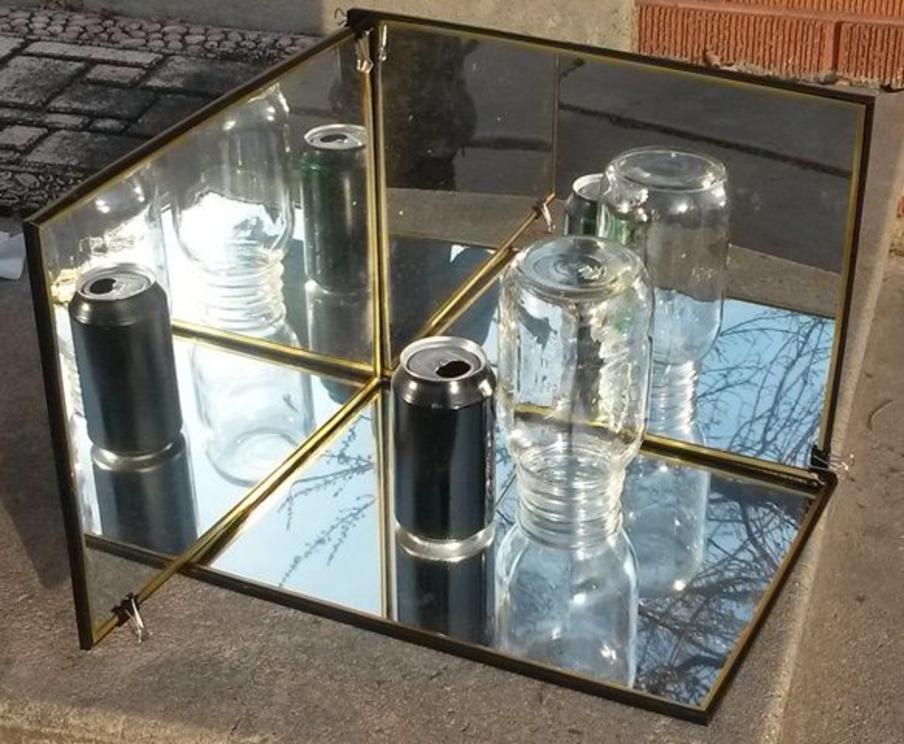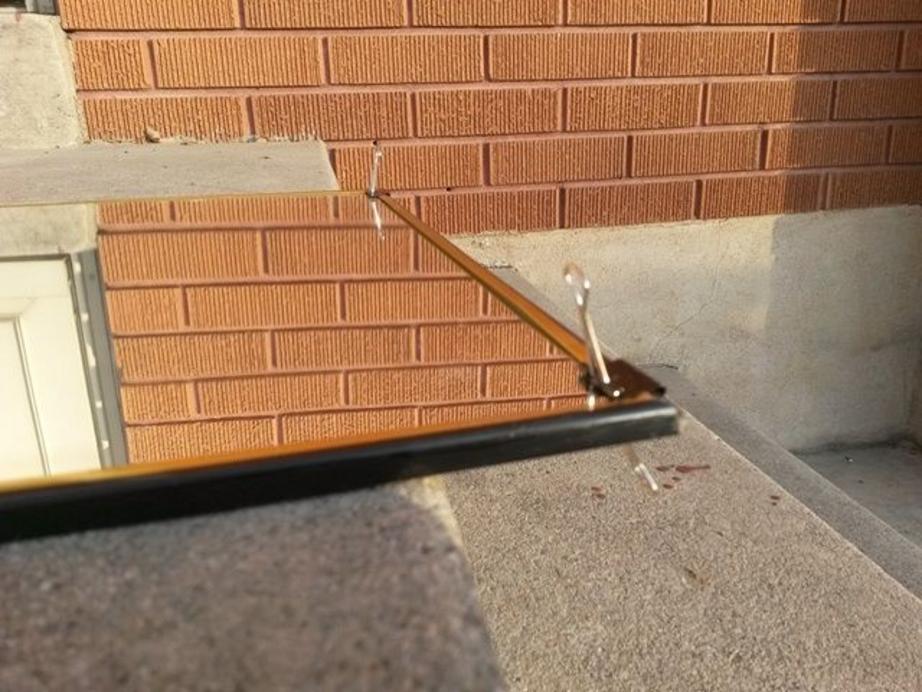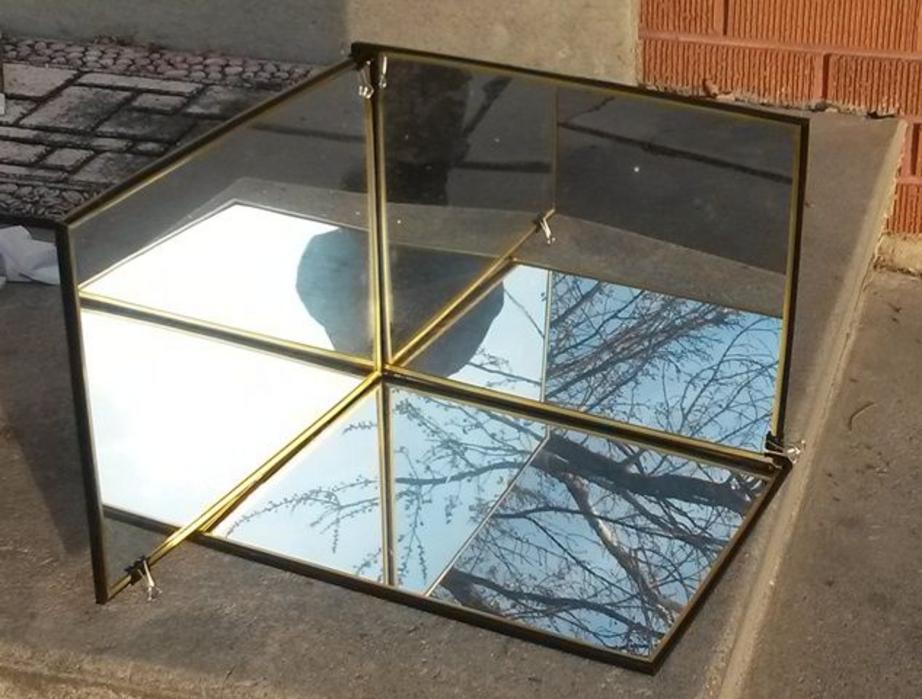Simple solar cooking jar
This instructable will show how to use
to pasteurize water or cook using only the sun and simple items from your pantry and kitchen.
Step 1: Needed Items

You will need:
- Mason Jars or large glass jars;
- black paint
- masking tape
- shiny reflective material
- oven bag or larger glass enclosure
- optional pop can
You can collect these and build it as a way to keep living costs down from regular use; or built as kits to be used later as needed; or they can be gathered in emergency situations. They can even come from your emergency storage as you use it, thus extending your fuel and reusing your waste. You may not find all of them in an emergency but enough could be found to set up a basic solar cook kit.
Step 2: Basic Premise & Science

The basic idea is to use heat from sun light captured in a container containing food or water to cook to heat water to pasteurize it to make it safe to drink.
Many people think they can store enough fuel to get them through any emergency situation. But without good discipline practices and rationing the way many people live today they will over use their fuel due to wasteful use, and common everyday practices they don't realize over uses fuel and other resources.
Anyway to use free, recurring fuel like the sun as often as possible helps extend fuel stores and gives you more understanding of how much fuel they waste.
When light hits any material many things can happen. It can be transmitted (passing through), reflected (bouncing off), refracted (change direction as I passes through media), absorbed (taken in), diffracted (bending and spreading), or scattered (reflected in all directions at random). We are hoping to use three of these to gain the heat we need to cook and pasteurize water: transmission, reflection, and absorption.
We want transmission of the light though a protective cover, reflection from the background material to concentrate more light on than would normally strike the target, and absorption of the light into the target. We want to minimize reflection off the target, and minimize absorption and reflection from the protective cover.
Dark flat colors on the target help to absorb as much light as possible. Clear protective cover protects the target from losing heat radiating from the target and cooling it. This heat loss can be increased when it is windy or if there are intermittent clouds or haze that limits the amount of light striking the target. The protective cover helps hold what heat gain you do get.
Step 3: Can Method

Find a pop can that fits in the mouth of your jar. Clean it out and wash it good. Paint the outside black and let it dry. The top can be painted but you need to keep the paint out of the inside of the can. While this is not an ideal situation as pop cans are lined with a thin layer of plastic, in an emergency the need for pasteurized water will be greater than the short term concerns of what may be given off from heating the plastic. Upgrade to a better option when you can. If you are building for future needs or building a kit for your emergency needs watch for dark colored metal containers that fix inside large jars.
Place a larger glass jar inverted over the can with both of them on the reflectors in the sun. My pop can didn't fit inside the regular mouth of the mason jar I used here. Sorry :(
Step 4: The Mason Jar
The Jar:
Get a Mason jar that is free from any chips or cracks. Second hand stores and estate sales can be a good place to pick up singles. There are two basic types of mason jars regular and wide mouth. The regulars have an opening or mouth slightly smaller than the size of a pop can. The wide mouths have an opening almost as large as the jar itself. Wide mouths are good for cooking or as protective covers for the pop can method. Weigh your options as to what you need and what you have. If you only have limited wide mouths save some for the can method. If you only have regulars you might have to try and find a smaller pop can to fit inside the mouth, like Redbull and similar slim can styles.

The Lid:
Most canning lids come in two pieces the lid and the ring. A solid lid may come with it if you are using a commercial jar like pickles, mayo, and others. The ring and lid are traditional canning lids consisting of a round flat metal lid, and a ring that has the threads that hold onto the jars threads and a lip that hold the lid to the jar. Ring and lids work by putting a lid on the jar and a ring over the lid and threading it down to hand tight. When canning the heating of the jar makes steam and air leave the jar, and the contents to expand. When taken from the heat a vacuum is made by the contents cooling and constricting thus pulling the lid down tight and sealing it.
When cooking we don't want the lid too tight so the heating doesn't build pressure in the jar. We don't want it to explode the jar or the contents explode out of the jar when opened. Some mason jar cooks have found out the hard and painful way having damaged jars fail or receiving a scalding when opening heated water or soup.
We are trying to hold the heat in to help in the cooking process but we want to do it safely. Don't tighten solid lids too much as they can't breath on their own, or drill a small hole in the top so pressure can be released before painting. Lid and rings can we used by not tightening them down tight and let the lid release pressure around its edges and the ring keeps it from falling off. The only problem can be when removing it from the heat, if it is left to cool the lid can be pulled down and seal the jar as the contents cool. A pressure hole the these lids can help release pressure and stop a vacuum from forming.
Clean It:
Prepare your mason jar by making sure it and the lid is clean. Most importantly it needs to be clean of oils and residue that can make the paint not stick. You can also rough up the surface of the jar by using sandpaper. Put the masking tape on the jar before to remind yourself what not to rough up.
Make sure it is dry and place a strip of masking tape up the side of jar from bottom to top. The tape will mask off the area to be used as a viewing window to see how what inside the jar is doing while in the sun. You can see if the water is boiling or your food is cooking.
The ends do not need to be pretty to get this to work, but if you want your project to look nice you can square your cuts or round them off for a more finished look. If it is an emergency situation use do what you can to get this going so you can start pasteurizing water and cooking and save your stored fuels.
Paint It:
Put the lid on so you can paint the lid and jar at the same time. You also don't want to have paint get on the threads of the jar. If you do it can stick the lid down tight when placed in sun and paint under the lid gets hot.
You can use regular flat black paint to do this, but there are some heat resistant paint available. Some are made just for metals so they may not last long on the glass jar. Again remember if you are doing this in an emergency use what paint you have. If it's gloss use some fine dust to dull it down while it is still wet. If you don't have black use the darkest paint you can find. If you are planning to make this project sans emergency for a fun family activity and learning experience then you can check out the best options for the best outcome. If you have gloss paint and only a little flat, use the gloss for the base coat(s), and finish with the flat.
Use your head don't die of dehydration, water borne illness, or starvation because you don't have everything perfect or as I present it here, find acceptable alternatives to get it done.
Once dry peel the tape off.


Step 5: Reflectors


The reflective material can be anything you can find with a shiny surface. If you can plan ahead get some mirrors from the dollar store and make your reflection area very nice. They will most likely be polycarbonate so they will be light and resist breaking but they won't provide as much heat as glass. The reduced weight and likeliness of breakage make up for it.
If you are just trying this out and don't want to go that far yet use tin foil shiny side facing the jar put on cardboard. In an emergency foil, pieces of a survival/space blanket (mylar) or the inside surface of a potato chip or snack bag (also mylar) attached to cardboard boards or whatever flat panel you can find to redirect sun light onto the jar.
Many of the early ones were made with used foil and pizza boxes and works just fine. You loose some sun light due to the winkled surface but enough can be redirected onto the jar to add more heat to it.
Again if it's an emergency use what you have. There is a possibility there will be a lot of debris after an emergency and scavenging mirrors from cars, broken homes, or old rear projection TVs can help you build your reflectors.
*Note: old rear projection TV's also have a Fresnel lens in the front that is really good for solar cooking or melting cement. This is covered in other instructables.
Before We Start Playing with the Reflectors
**CAUTION - Whenever you use reflected or focused sun light you need to use caution and prevent damage to your eyes. Just the light from the sun can damage your eyes, but multiplying the sun light into one spot increases the danger to your eyes. Even viewing the light focused from a Fresnel lens on the target surface can be bright enough to cause damage. Like watching an arc welder without the proper mask and lens.
Think how hot it can get in full sun. Now multiply that by 3 suns. That is what we are doing here taking the amount of sun that hits the target and multiplying it by about 3 (not totally 3 since there is lost light due to uncorrected angles of incidence). This can really be increased by using something like a large Fresnel lens (2' x 3' = 6 sqft) that can take the amount of light energy that strikes 6 sqrt feet and focus it down to strike an area of an inch or two. It becomes enough to melt steel and concrete. We don't need that much in this instructable.
Connecting the Reflectors
It is a good idea to work on putting them together inside or in the shade so you don't blind yourself shining the sun in your eyes.
Once you have your reflectors we are going to make half a cube with them. A bottom and two adjoining sides. With the dollar store mirrors it's easy they are squared and have enough rigidity to stand up.
When connecting your reflectors just remember depending on how good your reflectors are at reflecting the sun light and how hot they get can limit the effectiveness of what you use to connect them. Tape and glue may get hot and fail, clamps can get hot to touch but will hold. Modeling clay may help hold things together to get your shape right but in the sun it can melt and things fall apart. Tape and glue seems to work just fine for foil and mylar reflectors I'm going to try little office clamps on my dollar store mirrors. If you are planning ahead you can build a custom frame to hold it all and be more portable.
I tried the little binder clips from my office supply. They small ones I used were find to connect just few edges. I was able to get it to stand, by taping the clip handles to the backs. In an emergency you could just duct tape the edges together to build it. Just remember the adhesive of the tape may weaken over time in high temps and the reflectors come apart.
Step 6: Set It Up

Place the reflectors in a sunny spot early in the day, on a stable area. You don't want it being knocked over, or falling over in wind or your base collapsing. Using these little cooker methods take time to build up heat and cook so pick a south facing area that gets sun from early morning until late in the day.
It will so need to be an area you can regularly turn the reflector setup to realign with the sun. Start with the open corner of the base reflector pointed toward the sun and the closed corner lined up with the sun and front corner. Since the sun is a very busy guy always on the move, you will need to come out and turn the entire setup every so often to keep it aligned with the direct sunlight.
If you align it just ahead of the sun's position, you will still be catching enough sun to start heating, the sun will be moving into the best position for direct light, then start to move out of it. You can set it so you don't have to move it as often. That is unless you want it to be constantly in the best position for maximum light collection and maximum heat, then you will have to move it constantly to keep up. If you turn it too far ahead you can lose too much of the reflected light from the angle of incidence of the incoming light bouncing out of the target area.
Put your water or food in the jar but don't fill it much above where the jar narrows or about 1-1.5" from the top. You don't want what you are cooking to swell and block your pressure relief hole. Trust me it can be just as dangerous as tightening the lid on too tight.
My step-brother can attest to this from his days as a scout cooking in a can. A single nail hole in the top of a can of ravioli set on the side of the fire. He goes to goof off for a bit and a loud pop and little hot splatters of ravioli fly everywhere. One of the ravioli blocked the hole and the pressure built until the can failed and exploded all over tents the campsite and those unfortunate to be nearby.
Step 7: Place the Jar


Once the reflectors are set up place the jar on the reflectors near the rear corner. As the sun shines on the jar and reflectors it will begin to heat up. The dark color helps absorb more of the incoming light.
To increase the amount of heat retention in the jar and shield it from heat loss to wind put the jar inside an oven roasting bag before placing it on the reflectors. This helps shield the jar from wind and increases the ambient heat around the jar inside the bag, the clear bag allows the light to come through and be converted to absorbed energy. Any radiated heat coming from the jar is held inside the bag and near the jar to help increase the heat around and inside the jar. Since the roasting bags are already made for food use and to be used in a hot environment they are perfect for the job.
Monitor the jar and reflector. Adjust the reflectors angle it to keep up with the changing sun position. Check the jar that is is heating properly, is venting so it won't explode, and remove when the food is done.
You are going to have to test your times and when the food is done to know how long it takes to cook depending on the available sun. Times will also change depending on the time of year.
If you are using it to pasteurize water you can include a wapi (water pasteurization indicator) inside the jar that will tell you when the water is hot enough to be removed. When the wapi says its done it's done. You can add the water to your storage or use it.
Step 8: Mason Solar Cooking Jar
There you have it you have a solar cooking jar. You don't have to use your fuel storage while there is sun. You can use the sun as often as it is available.
You can make them up as kits to be put in your emergency supplies, use as a fun camping activity for the kids, or give them as gifts to your friends and family for their emergency preparedness needs.
I hope you liked this instructable and if you did share the love and vote for it in the mason jar contest.

